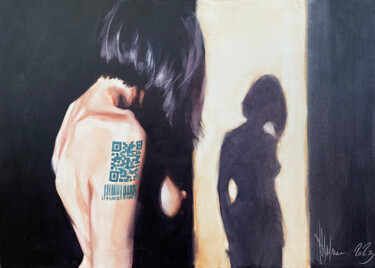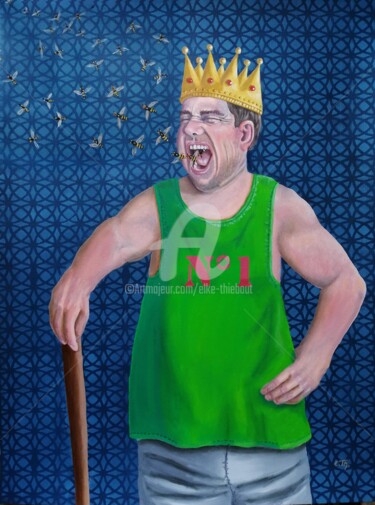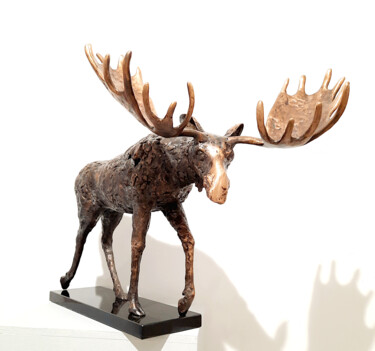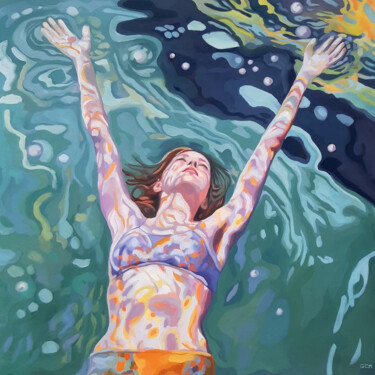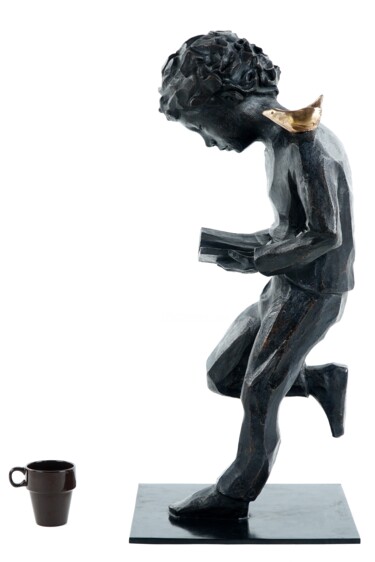Happy New Year 2024!
As has always been the case in our individual lives, another year has come to a close, and each of us is focused on drawing conclusions about it. In a way, this dynamic has also involved Artmajeur, which has decided to show you who the most popular artists of the past year were. In pursuit of this goal, however, I have combined the useful with the delightful, as each artist I present will tell us, through one of his works, a fragment of art history. In fact, I will start with the description of a painting, photograph, etc., which will be linked, when possible, to a specific art movement, and then finally culminate with the presentation of its creator. Happy 2024 again!
 WE LOVE YOUR FACE (2023)Painting by Brazo
WE LOVE YOUR FACE (2023)Painting by Brazo
 PURPLE CHROME GOLD SOUP SPLASH (2021)Sculpture by 2fast
PURPLE CHROME GOLD SOUP SPLASH (2021)Sculpture by 2fast
 EROS & PSYCHÉ (2022)Photography by Mathilde Oscar
EROS & PSYCHÉ (2022)Photography by Mathilde Oscar
Ten Best-Selling Artists of 2023
Mathilde Oscar
A winged young man, naked, kisses the forehead of a girl, caressing the skin of her breast with one hand. In the classical setting, other details emerge: a bow, a butterfly, and a loggia that opens onto a green landscape. Do you recognize these two characters? They are Cupid and Psyche, which links Oscar's photograph to the famous and ancient tradition of history painting. It's important to clarify that history painting is different from historical painting, which deals with history in the strict sense, beyond mythological, religious, and allegorical narratives. Cupid and Psyche are indeed characters from the Greek myth, known to us primarily through Apuleius' "Metamorphoses," where the story of a happy love is told, extensively reinterpreted in the historical-artistic narrative, culminating in Canova's eponymous masterpiece. Now, speaking of Oscar, born in Paris in 1980, she is a versatile artist whose career began with a deep passion for painting, fueled by her background in Art History. Her artistic journey has seen her transition from painting to graphic design, and she eventually embraced photography in 2013. In her photographs, Mathilde skillfully intertwines her love for the grand styles of Romanticism and Neoclassicism, often incorporating elaborate sets, costumes, and accessories into her work. Furthermore, she sometimes ventures into the realm of digital creation, adding a contemporary touch to her otherwise classical inspirations.
 LOVELY SEAL. ORIGINAL PAINTING (2020)Painting by Irena Aizen
LOVELY SEAL. ORIGINAL PAINTING (2020)Painting by Irena Aizen
Irena Aizen
An anthropomorphic giant bunny sits quietly by a pond, paying exclusive attention to what her hands, followed by her eyes, are doing: holding a domesticated seal with a leash, which allows itself to be pampered like a poodle. It is clear that we are in a surreal reality because what we see is not rationally possible, even though it is quite recurrent. In fact, if we look at all of Aizen's work, we notice that the long-eared character often appears, like a recurring motif, almost reminiscent of Chagall's supernatural and childlike world, where characters like the wandering Jew and the violinist have been depicted more than once. Similarly, Aizen's bunny faces a multitude of adventures within a complex pictorial narrative, often accompanied by strange pets or twin-like figures. In some cases, however, the artist's work also focuses exclusively on the genre of still life, where living animals appear in balanced object compositions. Irena Aizen is a Russian painter currently residing in Israel, who discovered her passion and inclination for art at an early age, as she was born into a third-generation family of artists. This context determined her dedication to painting from the age of ten onwards, and she later continued her artistic education at the Yaroslavl Art College in Yaroslavl Oblast, Russia.
 ABSTRACT 23105 (2023)Painting by Alex Senchenko
ABSTRACT 23105 (2023)Painting by Alex Senchenko
Alex Senchenko
A celestial background is divided into an upper and lower part. In the upper part of the support, there is an explosion of color, with the dynamism of yellow, fuchsia, blue, and orange standing out, while below, there is an almost omnipresent layer of white paint, which sometimes breaks to reveal what is beneath. This abstraction has also been described by the artist himself, who actively engages the viewer and expresses it in these words: "Immerse yourself in a world of vibrant art with 'Abstract 23105,' an abstract painting that is an explosion of bright and bold colors." Following these considerations, the painter describes his rich paint impasto as a kind of 3D effect, capable of adding depth to the environment it inhabits, as well as vibrancy and dynamic energy. The emphasis placed on color rather than the forms it could create in the real world invites the observer to explore the depth of the texture, directing them towards a clear concept of abstract expression in the language of painting. In fact, abstraction is the visual language of color, shapes, and signs par excellence, intended to convey thoughts, feelings, emotions, and experiences. It is important to emphasize that this form of art places less emphasis on the represented subject to valorize the methods and materials of creation. Finally, Alex Senchenko is a contemporary artist based in the United Kingdom, whose art has a clear purpose: to create metaphors of his unique perspective on life, described as "positive, dynamic, and simple," characterized by the clarity and pure intensity of color.
Gio Mondelli
I thought that Gio Mondelli, an Italian artist born in 1953, often takes his car, perhaps with an easel and brushes in the trunk, to go and observe the most beautiful and remote landscapes of the Bel Paese (Italy), places that give life to the following painterly representation of his vision: a yellow, very yellow field, possibly of wheat, culminates in the sea with sailing boats, all observed from the expanse of a vast sky. The painterly space of the sun's color also hosts a small house, enjoying the shade of two trees, making the depicted place closer to our real-life experience, despite the unreal vividness of the colors. It could be said that the most traditional and realistic genre of landscape, born in the Dutch Golden Age, may have looked to the example of the chromatic vividness of the Fauves, although the Italian painter arranges his strong colors with an unprecedented and studied precision, making it more ordered and closer to the narrative of reality. The effect is indeed comparable to a "photograph" with altered colors. Speaking of the painter, the beginning of his artistic career saw him involved in the study and experimentation of different artistic influences, with the intent to interpret them through ever innovative approaches, later leaning more towards surrealism, symbolism, and expressionism, mainly related to philosophical thoughts. Returning to the beginning of this paragraph, we can conclude by associating each colorful landscape of the artist with a real Italian landscape, reinterpreted through a highly personal sensitivity bridging different artistic expressions.
 EGG BOY DRESSED TO KILL (2024)Painting by Ta Byrne
EGG BOY DRESSED TO KILL (2024)Painting by Ta Byrne
Ta Byrne
The artwork depicts a figure dressed in a bowler hat and coat. A green apple floats in front of the man's face, obscuring it to a large extent. However, you can glimpse the man's eyes, which are just visible above the apple. Wait, but which artwork have I just described? I was actually talking about Magritte's "The Son of Man," a masterpiece that, as mentioned earlier, bears significant resemblances to Byrne's surrealism. This artist has indeed depicted a man with a bowler hat, replacing the apple with a much larger fried egg. In addition, "Egg Boy Dressed to Kill" features a white background rather than a landscape, showing only the bust of the portrayed model. As anticipated, Ta Byrne's style often aligns with the visions of Surrealism, a movement primarily aimed at harnessing the unconscious as a means to unleash the power of imagination, rejecting rationalism and realism in favor of drawing inspiration from psychoanalysis and the dream world. We can thus imagine that Ta Byrne, a Thai painter born in 1974, cooked a fried egg, only to dream it anthropomorphic in the evening and paint it the following day. Speaking a bit about Ta, she harbored a deep love for art but once considered becoming an artist an unattainable aspiration. However, everything changed with a simple sketch she created in 2010, marking a pivotal moment in her life. From that transformative drawing, the artist achieved remarkable artistic success, with her works adorning the interiors of homes, offices, hotels, and restaurants in over 66 countries worldwide!
 UNEXPECTED REACTION (WORK ON COMMISSION) (2023)Painting by Peter Duhaj
UNEXPECTED REACTION (WORK ON COMMISSION) (2023)Painting by Peter Duhaj
Peter Duhaj
Do you ever talk to your pets? Do you ever pick them up, look into their eyes, and make animal sounds from your mouth, attempting to communicate with them? I can confess without any shame that I do indeed have sincere conversations with my dog, who I am quite sure has all the tools to understand and interpret in his own way. Why am I saying these things? Because Duhaj's artwork, due to its hyperrealism, directly transported me into real life, reminding me of myself, my dog, but also all the people I've seen interact vividly with their pets. Speaking of Hyperrealism, it represents a relatively young form of artistic exploration, with its primary goal being the creation of illusions that emphasize and magnify the surrounding reality. To achieve this goal, hyperrealist artists use the intensity of color, lighting, contrast, and sharpness to bring forth representations that appear more vivid than what we commonly perceive with the naked eye. Regarding Duhaj, the contemporary Hungarian artist has been deeply influenced by prominent figures in the history of art in his country, nurturing a profound passion for colors and forms, as well as the ephemeral essence of moments since his youth. Although in the early stages of his career, Duhaj aspired to emulate masters like István Sándorfy, Zsolt Bodoni, László Nyári, and Tibor Csernus, his later focus has shifted towards portraying the human figure using a language that is a blend of Realism and Hyperrealism.
 I SUFFER, THEREFORE I AM ALIVE (2023)Painting by Miloš Hronec
I SUFFER, THEREFORE I AM ALIVE (2023)Painting by Miloš Hronec
Miloš Hronec
The characters portrayed by Hronec's Expressionism seem to be struck, overwhelmed, covered, and sometimes almost tortured by the colors that envelop them, capable of generating an emotional narrative that, on occasion, may even remotely resemble the more brutal and tormented modes of portraying the human figure in the style of Bacon. In fact, even the latter master, who often depicted wounded and emotionally scarred individuals, developed a distinctive style characterized by the exploration of the portrait genre, executed in a rather distorted and violent manner. Nevertheless, those who work following the aforementioned methods primarily aim to communicate intense emotions, ready to become genuine revelations of overwhelming emotional states. Milos Hronec, a contemporary Slovak painter, has been deeply influenced by the vibrant city of Bratislava, which has shaped his unique and diverse artistic identity, spanning oil painting, acrylics, spray paint, and drawing. In fact, Hronec's artistic expression is a fusion of Expressionism, Street art, and graffiti, incorporating both figurative and expressive elements, harmoniously blending established artistic approaches with spontaneous improvisations.
 N° - 741 (2023)Painting by Aykaz Arzumanyan
N° - 741 (2023)Painting by Aykaz Arzumanyan
Aykaz Arzumanyan
Oil painting on canvas, executed in relief and repeated across the entire surface, creates a monochromatic blue, interrupted only by a black "tile." If we forget this latter detail, along with the discourse on material art, we can also describe the artwork with these words: inspiration comes from the color of the sky, aiming to allude to the vastness of the infinite, conveyed by the use of a single color, intended to give the illusion of the eternal repeatability of the vision. Everything becomes an open window to freedom, offered by the opportunity to be surrounded by the power and concentration of a single color. What has just been written was inspired by the description of Yves Klein's "Blue Monochrome" (1961) by the MOMA in New York, intended to make us understand the partial affinity of Aykaz's painting with that of the French master. But what about the paint relief, which only appears in the example of the artist from Artmajeur? Now, the infinite seems more concrete and no longer tied to something immaterial; it is as if we could finally touch the sky, knowing that it remains forever infinite and unattainable. Aykaz Arzumanyan is an Armenian artist born in 1977, whose artistic activities encompass painting and plastic art, although he enthusiastically explores new techniques and materials. Through relentless dedication and constant commitment to his art, Arzumanyan has developed a distinctive style overflowing with vitality and enigma, brought to life by the recurrence of small chromatic details that stand out within the monochromes.
 RETRO WATERFRONT. (2023)Painting by Igor Shulman
RETRO WATERFRONT. (2023)Painting by Igor Shulman
Igor Shulman
On a sidewalk wall, two lovers meet in a kiss, embraced, with the woman so overwhelmed by passion that she has left her handbag aside. Leaving aside thoughts of a potential pickpocket's arrival, the entire scene is depicted in a realistic style, faithfully translating the qualities of the real world into artistic representation. However, this peculiarity should not be confused with the 1840s artistic movement intended to highlight the problems of modern society. Shulman's works, on the other hand, seem to portray everyday life without burdening it with problems, simply showing the beauty of scenes that come to life in the moment they are captured. Depth is still present in reality, as understood by the artist: "I am sharing fragments of my memory or my life. I know nothing but what I have lived and experienced. So, I share my emotions with people who can understand me. Mostly with my peers, people who have lived most of their lives." Speaking of Shulman, he is a Russian painter currently residing in Prague, inclined to experiment with various themes and painting styles, cleverly combining elements from various sources to create completely original and innovative works.
 BORN WITH A GOLDEN SPOON (2023)Painting by Pavel Filin
BORN WITH A GOLDEN SPOON (2023)Painting by Pavel Filin
Pavel Filin
Brushstrokes of color applied differently, sometimes resembling blotches, create a sort of acrobat, simply balancing on one leg, while the other, bent upon itself, holds a strange and ambiguous staff underneath. All of this happens while he is in his underwear, wearing a hat, a mask, and holding a golden spoon in his mouth. Perhaps this last detail was created in reference to the saying "born with a silver spoon in one's mouth," meant to allude to people of high social status. Returning to the application of color, it recalls Impressionism, an artistic movement that used rapid, dense brushstrokes, with touches of color placed side by side, sometimes not mixed or overlaid, where light, space, and forms were constructed solely through color. Speaking of blotches, perhaps it would also be relevant to think of the Macchiaioli, Italian "Impressionists," whose brush created overlapping spots of color to define masses of light and shadow. As for Filin, the artistic journey of the painter began in a quiet town on the Volga, where his early works mainly revolved around the landscape genre. However, he has always had a persistent desire to capture the essence of the human figure, exploring its movements and emotions, to the point that this subject has indeed become the main focus of his work.

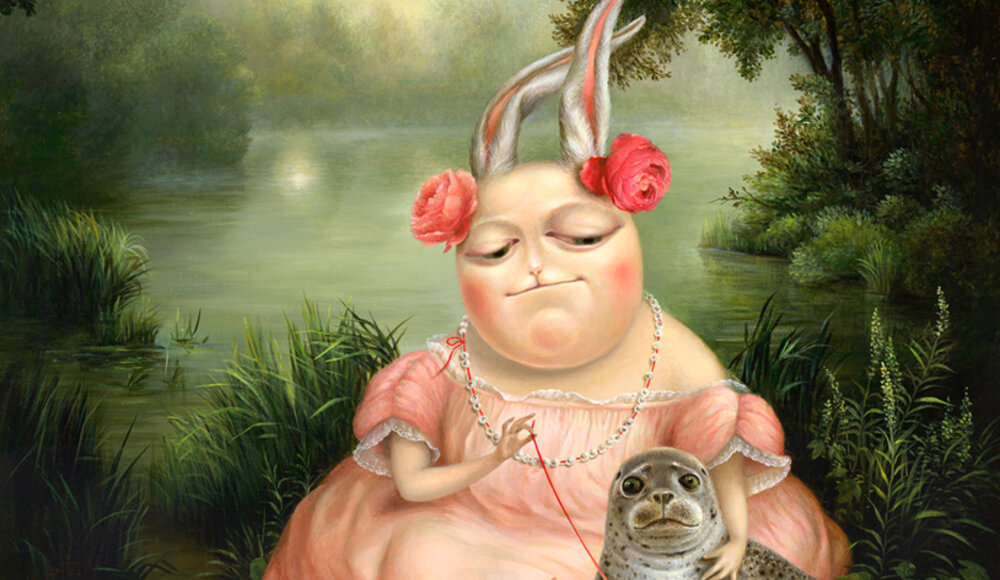

 Olimpia Gaia Martinelli
Olimpia Gaia Martinelli

